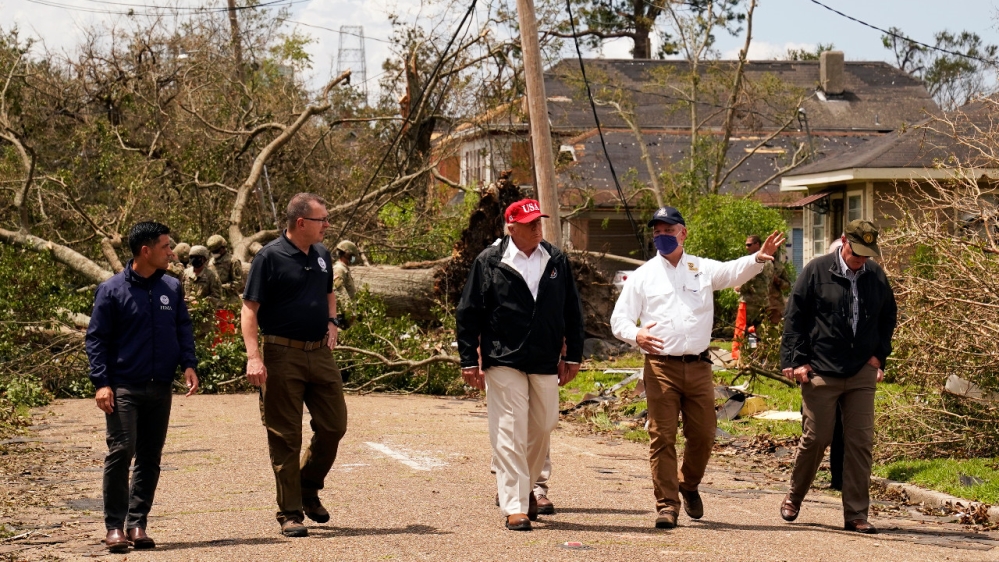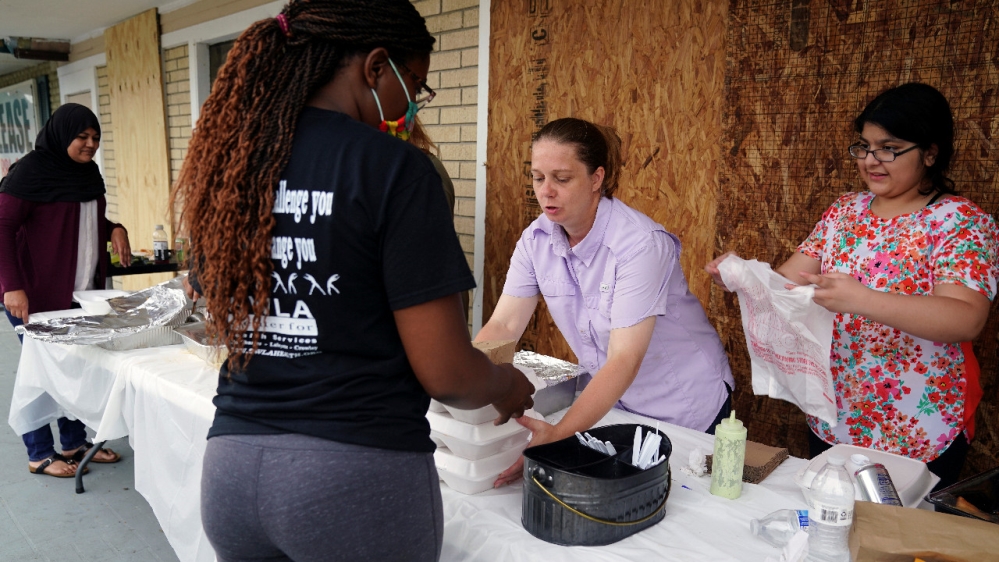Hurricane Laura: Thousands lack power, water as clean-up begins
President Trump visits Louisiana amid hurricane clean-up, as returning residents face power and water outages.

The clean-up has begun from Hurricane Laura as officials along the Louisiana coast warn returning residents they will face weeks without power or water.
The death toll from the category-four hurricane has reached 14, including 10 in Louisiana and four in Texas. Half of the deaths were attributed to carbon monoxide poisoning from the unsafe operation of generators.
Keep reading
list of 4 itemsThousands evacuate as wildfire grows ‘dramatically’ in western Canada
Photos: Flash floods in Afghanistan devastate lives and livelihoods
At least 28 dead, several missing in Indonesia flash floods, cold lava flow
United States President Donald Trump was was touring the damaged areas in Louisiana and neighbouring Texas on Saturday.
“I’m here to support the great people of Louisiana. It’s been a great state for me,” he said in Lake Charles. “It was a tremendously powerful storm.” He said he knows one thing about the state: “They rebuild it fast.”
During the slightly more than two hours he spent in the city, Trump met with officials and relief workers but not with any of the residents whose homes had been ripped apart in the storm.
His first stop was a warehouse being used as a staging area for the Cajun Navy, a group of Louisiana volunteers who help with search and rescue after hurricanes and floods. “Good job,” Trump told them.
Trump then toured a neighborhood with Governor John Bel Edwards and acting Homeland Security Secretary Chad Wolf, making his way down a street blocked by felled trees and where houses were battered by the storm, one with its entire roof torn off.
Edwards has said Laura was the most powerful hurricane ever to strike his state, surpassing even Hurricane Katrina, which was a category-three storm when it hit almost exactly 15 years ago. He said on Friday that officials now believe the surge was as high as 15 feet (4.5 meters).
“Whether you come from Louisiana or 5th Avenue In New York, you know about Katrina,” Trump said.

‘Incredible damage’
Across southwestern Louisiana, people were cleaning up from the destructive hurricane that roared ashore early on Thursday, packing 150-mph (240-kph) winds. Many were deciding whether they wanted to stay in miserable conditions or wait until basic services were finally restored.
Lauren Sylvester returned to her townhouse in Lake Charles on Friday after heeding a mandatory evacuation order and staying with her mother in a city about 95 miles (130 kilometres) away.
The inside of her unit was not directly damaged, but the roof lost shingles. Around her home, it was a different story. Power lines and trees were down.
“It’s still an incredible amount of damage,” said Sylvester, who was heading back to her mother’s house as soon as she finished cleaning up.

Simply driving was a feat in Lake Charles, a city of 80,000 residents hit head on by the hurricane’s eye. Power lines and trees blocked paths or created one-lane roads that drivers had to navigate with oncoming traffic.
Street signs were snapped off their posts or dangling. No stoplights worked, making it an exercise in trust with other motorists sharing the roads.
Mayor Nic Hunter cautioned that there was no timetable for restoring electricity and that water-treatment plants “took a beating,” leaving barely a trickle of water coming out of most taps.
“If you come back to Lake Charles to stay, make sure you understand the above reality and are prepared to live in it for many days, probably weeks,” Hunter wrote on Facebook.
Caravans of utility trucks were met on Friday by thunderstorms in the sizzling heat, complicating recovery efforts.
There were 464,813 customers without power in Louisiana on Friday, according to the site Poweroutage.us.
The Louisiana Department of Health estimated that more than 220,000 people were without water. Restoration of those services could take weeks or months, and full rebuilding could take years.
Forty nursing homes were relying on generators, and assessments were under way to determine if more than 860 residents in 11 facilities that had been evacuated could return.

Storm moves across Southern US
The much weaker remnants of the hurricane continued to move across the Southern US, unleashing heavy rain and isolated tornadoes. North Carolina and Virginia could get the brunt of the worst weather on Saturday, forecasters said.
When the storm moves back over the Atlantic Ocean, forecasters said it could become a tropical storm again and threaten Newfoundland, Canada.
Haiti’s civil protection service said 31 people had died due to Hurricane Laura, which blasted the island nation as a tropical storm last weekend before turning into a hurricane.